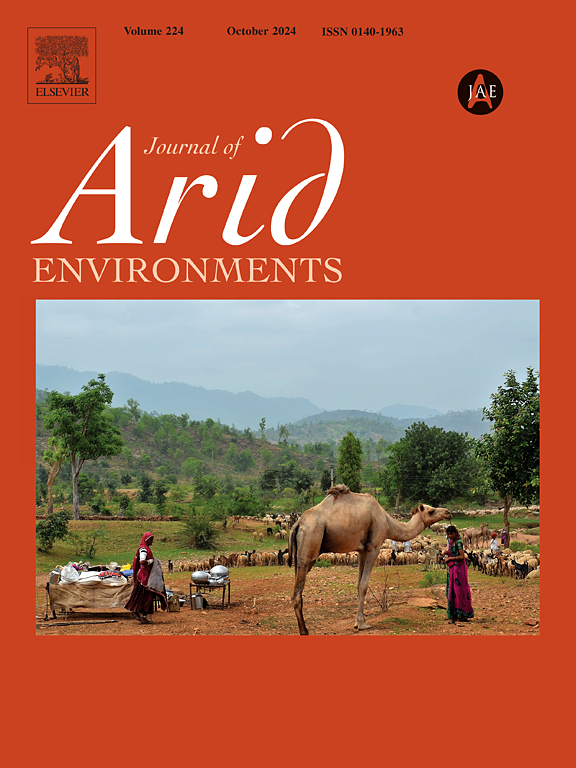莫哈韦沙漠原生牧草和外来入侵牧草的种子库响应受灌丛促进和干旱驱动
IF 2.5
3区 环境科学与生态学
Q2 ECOLOGY
引用次数: 0
摘要
在干旱生态系统中,土壤种子库通过储存对间歇性降雨作出反应的繁殖体来支持植物再生。不断变化的降水模式和干旱可能会改变种子库,对植物群落产生级联效应。本地一年生植物经常使用下注对冲(例如,延迟发芽)来应对变化的条件,而像Bromus rubens这样的入侵植物则喜欢快速生长和繁殖。灌木可以通过缓冲小气候和增加冠层下植物丰度来调节这些反应。然而,目前尚不清楚土壤种子库是否持续存在促进效应,以及它们如何受到干旱的影响。因此,我们的问题是:(1)土壤种子库中的种子是否在灌木冠层下比在间隙下更丰富?(2)干旱是否改变了灌木对土壤种子库的促进作用?(3)干旱条件是否会导致物种特定种子密度的突变,从而提示生态阈值?我们在美国内华达州金巴特国家纪念地的4个地点对土壤种子库进行了为期3年的采样,包括在干旱期间,在3种灌木树种下和开放的空隙中。分析了土壤种子库密度和组成与Palmer干旱严重指数(PDSI)的关系。干旱条件下褐雀稗种子密度下降,但灌木条件下种子密度较高,促进效应增强。原生牧草的种子密度表现为稳定或增加,微场差异较弱。物种丰富度和多样性随种子动态变化而变化。本研究强调了微站点变异性和物种特异性响应在土壤种子库形成中的作用,对干旱时期的恢复、入侵物种管理和生物多样性保护具有重要意义。本文章由计算机程序翻译,如有差异,请以英文原文为准。
Shrub facilitation and drought drive divergent soil seed bank responses of native forbs and invasive grass in the Mojave desert
In arid ecosystems, soil seed banks support plant regeneration by storing propagules that respond to episodic rainfall. Shifting precipitation patterns and drought may alter seed banks, with cascading effects on plant communities. Native annuals often use bet-hedging (e.g., delayed germination) to cope with variable conditions, while invasives like Bromus rubens favor rapid growth and reproduction. Shrubs can mediate these responses by buffering microclimate and increasing plant abundance beneath their canopies. However, it remains unclear whether facilitative effects persist in the soil seed bank and how they are influenced by drought. Therefore, we asked: (1) Are seeds in the soil seed bank more abundant under shrub canopies compared to interspaces? (2) Are shrub facilitation effects on soil seed banks modified by drought? and (3) Do drought conditions drive abrupt changes in species specific seed density suggesting ecological thresholds? We sampled soil seed banks over three years, including during drought, under three shrub species and in open interspaces at four sites in Gold Butte National Monument (Nevada, USA). Soil seed bank density and composition were analyzed in relation to the Palmer Drought Severity Index (PDSI). Bromus rubens seed density declined during drought but remained higher under shrubs, where facilitative effects intensified. Native forbs showed stable or increasing seed density and weaker microsite differences. Species richness and diversity varied with B. rubens seed dynamics. This study emphasizes the role of microsite variability and species-specific responses in shaping soil seed banks, with important implications for restoration, invasive species management, and biodiversity conservation during drought.
求助全文
通过发布文献求助,成功后即可免费获取论文全文。
去求助
来源期刊

Journal of Arid Environments
环境科学-环境科学
CiteScore
5.70
自引率
3.70%
发文量
144
审稿时长
55 days
期刊介绍:
The Journal of Arid Environments is an international journal publishing original scientific and technical research articles on physical, biological and cultural aspects of arid, semi-arid, and desert environments. As a forum of multi-disciplinary and interdisciplinary dialogue it addresses research on all aspects of arid environments and their past, present and future use.
 求助内容:
求助内容: 应助结果提醒方式:
应助结果提醒方式:


